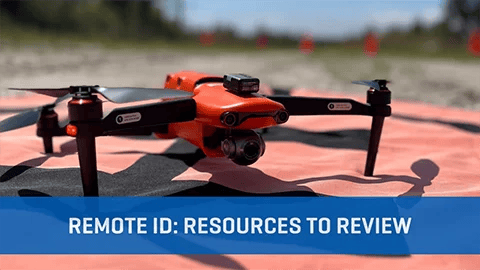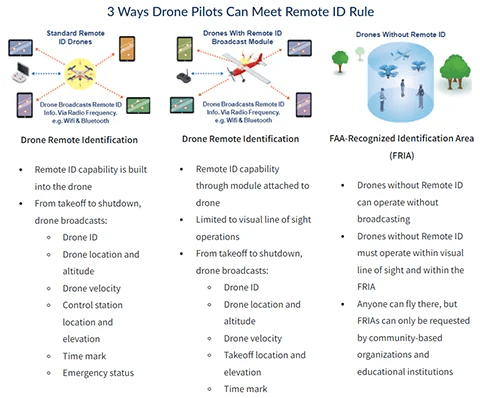.webp?width=1020&height=573&name=Remote%20ID%20Resources%20to%20Review%20(1).webp)

Resources to Help Prepare for the New Remote ID Rule
All remote pilots will be required to comply with the Remote Identification (also called Remote ID or RID) rule starting September 16, 2023, according to the Federal Aviation Administration (FAA) announcement. 9/13/23 UPDATE: The RID Deadline has been extended for discretionary enforcement until March 16, 2024; so don't wait! Keep working toward compliance today.
USI is here to support UAS operators, educators and instructors to make sure you are ready and prepared for this new rule.
This blog is the third of our three-part series about Remote ID, and includes resources you need to know about as they may help you prepare for the new Remote ID requirements.
What is Remote ID?
The FAA defines Remote ID as the ability of a drone in flight to provide identification and location information that can be received by other parties.
Why is Remote ID Important?
Drones or unmanned aircraft systems (UAS) are the fastest growing segment of the aviation industry. The FAA is committed to working to fully integrate drones into the National Airspace System (NAS) safely -- UAS remote identification is crucial to their integration plan.
As described by the FAA, "Remote ID helps the FAA, law enforcement, and other federal agencies find the control station when a drone appears to be flying in an unsafe manner or where it is not allowed to fly. Remote ID also lays the foundation of the safety and security groundwork needed for more complex drone operations."
Will Remote ID Impact Me?
Yes! If you are a drone pilot, UAS instructor, are operating an uncrewed aircraft in any way for any purpose, or if you have or are starting a drone program, you are required to meet the identification requirements of the remote ID rule which goes into effect September 16, 2023 with discretionary enforcement until March 16, 2024.
There are three options for compliance:
- Use a Remote ID Capable Drone
- Attach a Remote ID Broadcast Module to a Drone that doesn't have it built in
- Operate a Drone without Remote ID within an FAA-Recognized Identification Area (FRIA)
.webp?width=893&height=740&name=image-png-3%20(1).webp)

What Can I Do With My Drones That Don't Have Remote ID?
If you already have a drone or a fleet of drones that are not Remote ID capable, you may want to consider attaching a broadcast module that will enable Remote ID on the remotely piloted aircraft system (RPAS) so you don't have to completely replace your fleet.
Your other option is to fly within a designated FRIA, which you need to apply for. Please note that this option does limit the operating area for your flight plan and may compromise your goals.
How Do I Find Remote ID Broadcast Modules That Are FAA Compliant?
USI is committed to supporting the organizations, schools, universities, instructors, and operators who need help with preparing for Remote ID. In order to be able to do that, USI has been testing broadcast modules that are compliant with the FAA to provide this list of potential solutions for your existing drone or fleet. We will be adding to this list as further testing takes place.
- Dronetag Mini - this 32 g / 1.1 oz module was designed with expert pilots in mind. Combination of both Network & Direct / Broadcast Remote ID to make your drone flight safe & compliant. Review FAA Compliance details here.
- Dronetag Beacon - at 16 g / 0.56 oz, the add-on makes drones instantly compliant with the latest RID standards. Review FAA Compliance details here.
If you decide to move forward with either of these options, please mention "Fly USI" during your purchase and we will send you a USI hat!
Where Can I Learn More About Remote ID?
We hope this blog series has been helpful to you as you navigate the new Remote ID rules that will take place March 16, 2024. Here are additional sites and resources to review as you research the best options to ensure your operation is ready for Remote ID and compliant with the new rule.
- Remote ID Requirements: What Schools Need to Know
- Remote ID for Drones is Coming, What Should You Do?
- Remote ID: Commercial Requirements
- What You Need to Know About the FAA's Remote ID Requirements
- UAS Remote Identification - FAA Website
- FAA Remote ID Toolkit (PDF)
- Remote ID for Industry and Standards Bodies
- Drone Remote ID - What is Remote ID?
- Remote ID Executive Summary (PDF)
- Part 89 - Remote ID - Code of Federal Regulations
- UAS Declaration of Compliance
- Remote ID Rules - Are You Ready?
- Is Your Aircraft Compliant? - Search Here
As regulations change and restrictions are enabled, we suspect that the industry will experience major growth. The new rules that are being implemented are creating new areas of opportunity and improving safety within the NAS.
If you have any questions about Remote ID, standing up, or scaling your drone program, department, or business, please feel free to reach out to USI!
👉👉 Stay in touch with USI - Subscribe to our Monthly Safety Brief! 👈👈
.png?width=135&height=90&name=Website%20Main%20Nav%20Logo%20(151%20%C3%97%20100%20px).png)